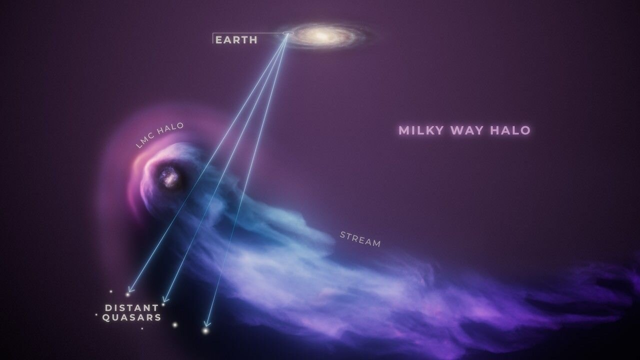The Hubble Space Telescope revealed how the Milky Way "blows away" the matter from a neighboring galaxy.
Using telescopes, astronomers have discovered dozens of satellite galaxies around the Milky Way, but two of them have been visible to the naked eye since ancient times: the Magellanic Clouds. Some stars within them are nearly as old as our galaxy, dating back over 11 billion years. This means they "were born" around the same time as all the galaxies in the universe. For a long time, astronomers considered the Magellanic Clouds to be irregular galaxies, but modern tools allow for the tracking of a sort of spiral structure, at least in the Large Cloud.
Determining when they encountered the Milky Way is challenging, but it is estimated to have occurred about 1-2 billion years ago. Interestingly, this timeframe roughly corresponds to the period it takes for the Large Magellanic Cloud to complete one orbit around our massive disk. Thus, at least one orbit has been completed during their coexistence, and it is unlikely to manage more than a couple more: astronomers predict that in one and a half to two billion years, it will be "consumed" by our galaxy.
However, there is an entirely different forecast: some scientists believe that it is not a satellite of the Milky Way at all—it is merely passing by. In any case, the Large Magellanic Cloud is the largest dwarf galaxy in our immediate vicinity. Estimates suggest it is about 150,000 light-years away, and its several billion stars occupy a space of approximately 30,000 light-years. The Milky Way is several times larger and hundreds of times more massive.
Like any galaxy, the Large Magellanic Cloud resides within what is known as a halo—a vast spherical "cocoon." Astrophysicists suggest that it is primarily composed of the famous dark matter, but it also contains familiar matter—hydrogen, the "primordial" substance of the universe. This forms what is known as a gas "corona" around the galaxy. Recently, astronomers from the Institute for Space Research used a space telescope (from the USA) to observe it through Hubble.
In their recent article (available on the preprint server arXiv.org), they reported that the faint gas was made visible by the light from 28 quasars—active nuclei of distant young galaxies that are often referred to as cosmic beacons due to their brightness. Thanks to these observations, it was discovered that the gas halo surrounding the Large Magellanic Cloud is about ten times smaller than expected given its mass: only about 50,000 light-years in diameter.

Moreover, it was found that a massive stream, a "tail" of this gas, extends behind the galaxy. Scientists explain that the Milky Way "blows" on its small neighbor like a hairdryer. This is due to tidal forces, meaning gravity, and also, as suspected, "ram pressure," similar to what occurs when an object moves through a liquid medium.
According to the researchers, the dwarf galaxy barely withstands such pressure and miraculously retains interstellar gas—the "building material" for forming new stars, without which the galaxy would have long since turned into a cosmic "retirement home" akin to a globular cluster.